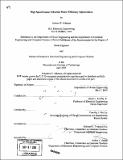| dc.contributor.advisor | James L. Kirtley, Jr. | en_US |
| dc.contributor.author | Johnson, Andrew P. (Andrew Peter) | en_US |
| dc.contributor.other | Massachusetts Institute of Technology. Dept. of Electrical Engineering and Computer Science. | en_US |
| dc.date.accessioned | 2006-07-31T15:12:52Z | |
| dc.date.available | 2006-07-31T15:12:52Z | |
| dc.date.copyright | 2005 | en_US |
| dc.date.issued | 2005 | en_US |
| dc.identifier.uri | http://hdl.handle.net/1721.1/33562 | |
| dc.description | Thesis (Nav. E.)--Massachusetts Institute of Technology, Dept. of Ocean Engineering; and, (S.M.)--Massachusetts Institute of Technology, Dept. of Electrical Engineering and Computer Science, 2005. | en_US |
| dc.description | Includes bibliographical references (p. 107-108). | en_US |
| dc.description.abstract | One of the reasons linear motors, a technology nearly a century old, have not been adopted for a large number of linear motion applications is that they have historically had poor efficiencies. This has restricted the progress of linear motor development. The concept of a linear motor as a rotary motor cut and laid out flat with a conventional rotary motor control scheme as a design basis may not be the best way to design and control a high-speed linear motor. End effects and other geometry subtleties of a linear motor make it unique, and a means of optimizing efficiency with both the motor geometry and the motor control scheme will be analyzed to create a High-Speed Linear Induction Motor (LIM) with a higher efficiency than what is possible with conventional motors and controls. This thesis pursues the modeling of a short secondary type Double-Sided Linear Induction Motor (DSLIM) that is proposed for use as an Electromagnetic Aircraft Launch System (EMALS) aboard the CVN-2 1. Mathematical models for the prediction of effects that are peculiar to DSLIM are formulated, and their overall effects on the performance of the proposed machine are analyzed. | en_US |
| dc.description.abstract | (cont.) These effects are used to generate a transient motor model, which is then driven by a motor controller that is specifically designed to the characteristics of the proposed DSLIM. Due to this DSLIM's role as a linear accelerator, the overall efficiency of the DSLIM will be judged by the kinetic energy of the launched projectile versus the total electric energy that the machine consumes. This thesis is meant to propose a maximum possible efficiency for a DSLIM in this type of role. | en_US |
| dc.description.statementofresponsibility | by Andrew P. Johnson. | en_US |
| dc.format.extent | 189 p. | en_US |
| dc.format.extent | 6915839 bytes | |
| dc.format.extent | 6923757 bytes | |
| dc.format.mimetype | application/pdf | |
| dc.format.mimetype | application/pdf | |
| dc.language.iso | eng | en_US |
| dc.publisher | Massachusetts Institute of Technology | en_US |
| dc.rights | M.I.T. theses are protected by copyright. They may be viewed from this source for any purpose, but reproduction or distribution in any format is prohibited without written permission. See provided URL for inquiries about permission. | en_US |
| dc.rights.uri | http://dspace.mit.edu/handle/1721.1/7582 | |
| dc.subject | Ocean Engineering. | en_US |
| dc.subject | Electrical Engineering and Computer Science. | en_US |
| dc.title | High speed linear induction motor efficiency optimization | en_US |
| dc.type | Thesis | en_US |
| dc.description.degree | S.M. | en_US |
| dc.description.degree | Nav.E. | en_US |
| dc.contributor.department | Massachusetts Institute of Technology. Department of Electrical Engineering and Computer Science | |
| dc.contributor.department | Massachusetts Institute of Technology. Department of Ocean Engineering | |
| dc.identifier.oclc | 63282386 | en_US |
